Cell Shock, Corsair, and Kingston Introduce Ultra Speed DDR3
by Wesley Fink on October 11, 2007 10:00 PM EST- Posted in
- Memory
The Contenders
In addition to the Super Talent and OCZ offerings, three new high-profile DDR3-1800 kits have been introduced in the last few weeks. Cell Shock is a new name from Germany, and they have quickly become the new darling of the extreme enthusiast. Corsair is very well known as an enthusiast memory manufacturer and introduced their DDR3-1800 shortly after we reviewed the OCZ memory. Kingston is the world's largest memory manufacturer and has just introduced their DDR3-1800 (and DDR3-1625) memory kits.
Cell Shock
Cell Shock will likely be a new name for most of our readers. The company is a new division of MSC Vertriebs GmbH in Germany. MSC has around 1000 employees and several production facilities in Germany, Scotland, and Malta. It was established by the current managing director in 1982 and grew from a very small company to an international player in the distribution of semiconductors and the manufacture of electronic applications. Today MSC mainly serves industrial clients in Europe. The customer base includes partners in medical, IT, energy, automotive, and other sectors. MSC Vertriebs GmbH is privately held by the owner who is acting as managing director.
MSC was already a partner with major manufacturers of semiconductors like Samsung, Micron, Infineon, etc., which made the move to the retail memory market a natural extension of the MSC product line. Due to the expertise MSC had gained in developing and producing memory modules for the industrial market, the company decided to establish the Cell Shock brand. The new brand is targeted at the enthusiast market. More information on Cell Shock can be found at the Cell Shock website.
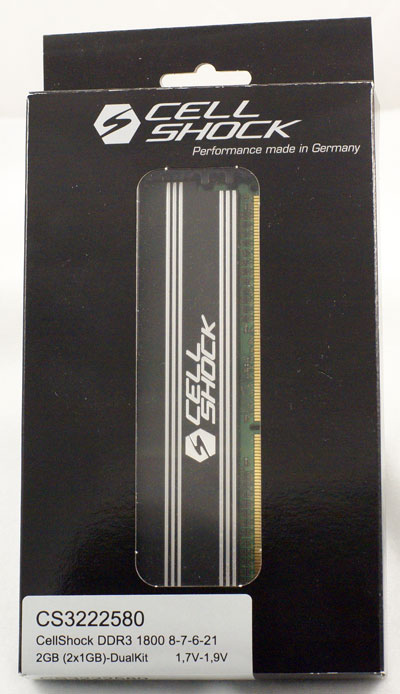
Cell Shock's packaging for the DDR3-1800 DIMM kit mirrors the black and silver theme of the DIMMs. There is very little info on the glossy black folding carton, but the info that is there is in six languages. The international flavor of this German memory is immediately apparent.

The DIMMs themselves are shrouded in heavy black and silver heatsinks that appear to be cast aluminum. The memory is attractive, with raised logos, and the heatsinks are also very heavy as heatsinks go. Cell Shock rates the memory at DDR3-1800 at 1.7V to 1.9V. They do not specify maximum voltage, but other Micron Z9-based memory has topped out at 2.1V to 2.2V with supplemental air cooling.
The only configuration for DDR3-1800 is a 2GB (2x1GB) kit. Cell Shock also markets Micron memory chips in a DDR3-1600 2GB kit rated at 7-6-6-18 timings. Cell Shock provides a 5-year warranty on the DDR3-1800 memory, and they tell us it is not a Lifetime Warranty only because legal counsel advises a Lifetime Warranty is not possible in the EU.
Corsair
Corsair hardly requires an introduction, as it is probably the most recognized brand of enthusiast memory in the world. Corsair has been an innovator in the enthusiast memory market for many years. Corsair often partners with motherboard manufacturers, Intel, and AMD in the launches of new chipsets and boards. As a result every major reviewer is very familiar with Corsair products.
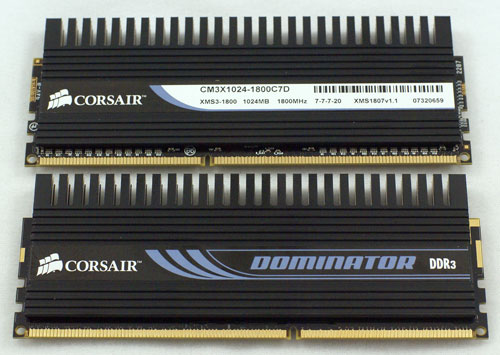
The Corsair DDR3-1800 comes in the familiar folding clamshell package. The DIMMs are typical of the Corsair DHX Dominator series. DHX, or dual-path cooling, is a proprietary Corsair feature to improve cooling. It is described in detail in an earlier review of Corsair Dominator memory if you want to know more about it. Basically the two sets of fins cool both the PCB and the memory chips separately to theoretically improve cooling.
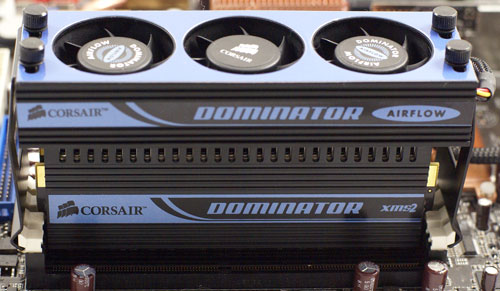
Corsair also provided a Dominator memory cooler with the pair of DIMMs. This effective memory topper helps keep you memory cool and it is available separately for those who want to add it to their system. It works well with any DDR3/DDR2/DDR memory. We use the Dominator fan or the CoolIT RAM Fan in all our memory tests.
The Dominator DDR3-1800 is offered in a 2GB kit or in the same 2GB configuration designed to support the Intel Extreme Memory Profiles (XMP).
Kingston
Kingston is the world's largest memory manufacturer. As a result you will find Kingston's products available at almost every computer retailer. Headquartered in Fountain Valley, California, Kingston has grown from its beginnings with a single product in 1987 to $3.4 Billion in sales last year and a catalog of over 2000 memory products. Kingston is by far the world's largest independent memory manufacturer, and it is more than three times larger than the closest competitor.
Everyone knows Kingston makes computer memory, but not everyone knows that Kingston is also a manufacturer of memory for the computer enthusiast. In the high-end memory market Kingston seems to always provide competitive products in their HyperX line, and they are large enough to often be first to market with new memory technology. The recent introduction of the PC3-14400 (DDR3-1800) is just another example of Kingston's aggressive move into the high-end memory space.
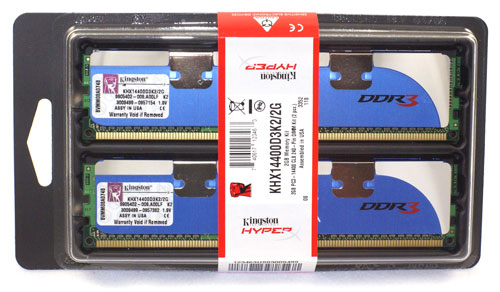 /
/
Kingston continues to use rather conservative packaging for their memory. Competitors have moved to flashier presentations of their product, but the Kingston packaging is the same whether the product is value RAM or high-end HyperX.
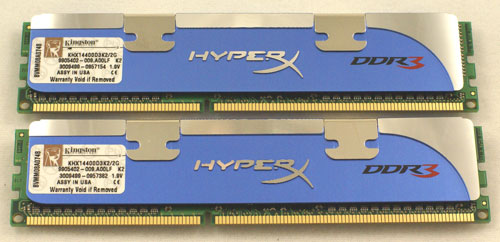
Fortunately Kingston has been paying much more attention recently to the appearance of the DIMM itself. While the DDR3-1800 still sports the characteristic sky blue color that says HyperX, this is certainly the flashiest HyperX DIMM we've ever seen. The mirror trim, sky blue, and heavy cast heatsink are truly unique and certainly stand out. We like the new HyperX appearance; it almost says something exciting is going on here, and in this case it is.
Kingston also announced their KHX13000D3LL (DDR3-1625 CAS7) at the same time. We also took a look the low-latency 7-7-7 kit in our testing, but we did not report results separately. The reason for this:
In every test result the Kingston DDR3-1800 and DDR3-1625 performed exactly the same! They achieved the same overclock and timings/voltage in every test performed. Therefore you can consider all test results to apply equally to KHX14400D3K2/2G and KHX13000D3LLK2/2G. The two memories have an MSRP of around $450 for the 2GB kit. They are also priced within $3 to $5 of each other so you can select either Kingston memory based on best price.
It should be pointed out that Kingston, like other enthusiast memory makers, promises you the performance will be at least as good as rated. It may be much better, and usually is in the Micron Z9-based memory tested here, but higher performance is not guaranteed. The rated "guaranteed" speed may be an important factor to you. The Kingston DDR3-1800 is rated at DDR3-1800 at 8-8-8-24 at 1.9V, and the DDR3-1625LL is rated at DDR3-1625 at 7-7-7-20 at 1.9V.
In addition to the Super Talent and OCZ offerings, three new high-profile DDR3-1800 kits have been introduced in the last few weeks. Cell Shock is a new name from Germany, and they have quickly become the new darling of the extreme enthusiast. Corsair is very well known as an enthusiast memory manufacturer and introduced their DDR3-1800 shortly after we reviewed the OCZ memory. Kingston is the world's largest memory manufacturer and has just introduced their DDR3-1800 (and DDR3-1625) memory kits.
Cell Shock
Cell Shock will likely be a new name for most of our readers. The company is a new division of MSC Vertriebs GmbH in Germany. MSC has around 1000 employees and several production facilities in Germany, Scotland, and Malta. It was established by the current managing director in 1982 and grew from a very small company to an international player in the distribution of semiconductors and the manufacture of electronic applications. Today MSC mainly serves industrial clients in Europe. The customer base includes partners in medical, IT, energy, automotive, and other sectors. MSC Vertriebs GmbH is privately held by the owner who is acting as managing director.
MSC was already a partner with major manufacturers of semiconductors like Samsung, Micron, Infineon, etc., which made the move to the retail memory market a natural extension of the MSC product line. Due to the expertise MSC had gained in developing and producing memory modules for the industrial market, the company decided to establish the Cell Shock brand. The new brand is targeted at the enthusiast market. More information on Cell Shock can be found at the Cell Shock website.

Cell Shock's packaging for the DDR3-1800 DIMM kit mirrors the black and silver theme of the DIMMs. There is very little info on the glossy black folding carton, but the info that is there is in six languages. The international flavor of this German memory is immediately apparent.

The DIMMs themselves are shrouded in heavy black and silver heatsinks that appear to be cast aluminum. The memory is attractive, with raised logos, and the heatsinks are also very heavy as heatsinks go. Cell Shock rates the memory at DDR3-1800 at 1.7V to 1.9V. They do not specify maximum voltage, but other Micron Z9-based memory has topped out at 2.1V to 2.2V with supplemental air cooling.
| Cell Shock DDR3-1800 (PC3-14400) Memory Specifications |
|
| Configuration | 2 GB Kit (2x1GB) |
| Rated Timings | 8-7-6-21 at DDR3-1800 |
| Rated Voltage | 1.7-1.9V (Standard 1.5V) |
| Module Info | Micron chips, unbuffered, non-ECC |
| Warranty | 5 Years |
The only configuration for DDR3-1800 is a 2GB (2x1GB) kit. Cell Shock also markets Micron memory chips in a DDR3-1600 2GB kit rated at 7-6-6-18 timings. Cell Shock provides a 5-year warranty on the DDR3-1800 memory, and they tell us it is not a Lifetime Warranty only because legal counsel advises a Lifetime Warranty is not possible in the EU.
Corsair
Corsair hardly requires an introduction, as it is probably the most recognized brand of enthusiast memory in the world. Corsair has been an innovator in the enthusiast memory market for many years. Corsair often partners with motherboard manufacturers, Intel, and AMD in the launches of new chipsets and boards. As a result every major reviewer is very familiar with Corsair products.

The Corsair DDR3-1800 comes in the familiar folding clamshell package. The DIMMs are typical of the Corsair DHX Dominator series. DHX, or dual-path cooling, is a proprietary Corsair feature to improve cooling. It is described in detail in an earlier review of Corsair Dominator memory if you want to know more about it. Basically the two sets of fins cool both the PCB and the memory chips separately to theoretically improve cooling.

Corsair also provided a Dominator memory cooler with the pair of DIMMs. This effective memory topper helps keep you memory cool and it is available separately for those who want to add it to their system. It works well with any DDR3/DDR2/DDR memory. We use the Dominator fan or the CoolIT RAM Fan in all our memory tests.
| Corsair DDR3-1800 (TWIN3X2048-1800C7DF G) Memory Specifications |
|
| Configuration | 2 GB Kit (2x1GB) |
| Rated Timings | 7-7-7-20 at DDR3-1800 |
| Rated Voltage | 2.0V (Standard 1.5V) |
| Module Info | Micron chips, Unbuffered, non-ECC |
| Warranty | Lifetime |
The Dominator DDR3-1800 is offered in a 2GB kit or in the same 2GB configuration designed to support the Intel Extreme Memory Profiles (XMP).
Kingston
Kingston is the world's largest memory manufacturer. As a result you will find Kingston's products available at almost every computer retailer. Headquartered in Fountain Valley, California, Kingston has grown from its beginnings with a single product in 1987 to $3.4 Billion in sales last year and a catalog of over 2000 memory products. Kingston is by far the world's largest independent memory manufacturer, and it is more than three times larger than the closest competitor.
Everyone knows Kingston makes computer memory, but not everyone knows that Kingston is also a manufacturer of memory for the computer enthusiast. In the high-end memory market Kingston seems to always provide competitive products in their HyperX line, and they are large enough to often be first to market with new memory technology. The recent introduction of the PC3-14400 (DDR3-1800) is just another example of Kingston's aggressive move into the high-end memory space.

Kingston continues to use rather conservative packaging for their memory. Competitors have moved to flashier presentations of their product, but the Kingston packaging is the same whether the product is value RAM or high-end HyperX.

Fortunately Kingston has been paying much more attention recently to the appearance of the DIMM itself. While the DDR3-1800 still sports the characteristic sky blue color that says HyperX, this is certainly the flashiest HyperX DIMM we've ever seen. The mirror trim, sky blue, and heavy cast heatsink are truly unique and certainly stand out. We like the new HyperX appearance; it almost says something exciting is going on here, and in this case it is.
| Kingston KHX14400D3K2/2G (DDR3-1800 CAS 8) Memory Specifications |
|
| Configuration | 2 GB Kit (2x1GB) |
| Rated Timings | 8-8-8-24 at DDR3-1800 |
| Rated Voltage | 1.9V (Standard 1.5V) |
| Module Info | Micron chips, Unbuffered, non-ECC |
| Warranty | Lifetime |
Kingston also announced their KHX13000D3LL (DDR3-1625 CAS7) at the same time. We also took a look the low-latency 7-7-7 kit in our testing, but we did not report results separately. The reason for this:
In every test result the Kingston DDR3-1800 and DDR3-1625 performed exactly the same! They achieved the same overclock and timings/voltage in every test performed. Therefore you can consider all test results to apply equally to KHX14400D3K2/2G and KHX13000D3LLK2/2G. The two memories have an MSRP of around $450 for the 2GB kit. They are also priced within $3 to $5 of each other so you can select either Kingston memory based on best price.
It should be pointed out that Kingston, like other enthusiast memory makers, promises you the performance will be at least as good as rated. It may be much better, and usually is in the Micron Z9-based memory tested here, but higher performance is not guaranteed. The rated "guaranteed" speed may be an important factor to you. The Kingston DDR3-1800 is rated at DDR3-1800 at 8-8-8-24 at 1.9V, and the DDR3-1625LL is rated at DDR3-1625 at 7-7-7-20 at 1.9V.










12 Comments
View All Comments
geok1ng - Thursday, August 28, 2008 - link
looking at http://www.anandtech.com/mb/showdoc.aspx?i=3208&am...">http://www.anandtech.com/mb/showdoc.aspx?i=3208&am... one may wish that an E8600 can reach 10x400Mhz using 2:1 divider + tRD 5 + DDR3 1600 for top notch performance. I look forward for FSB 400/DDR3 1600 CAS 6 examples of memory performance.mandos9 - Tuesday, November 6, 2007 - link
"The recent performance improvements in DDR3 memory have far exceeded anything the end user or industry expected to see in such a short period of time. "The performance improvement is,in comparison to ddr2,5-7fps.That's almost nothing,especially when the games you test already run at 100+ fps(why don't you test it on the crysis demo or games that have come out more recently?).
I don't see why i should spend 600(or 300 for that matter) euro to upgrade my pc, when i can buy a second 8800GT for 250 euro and get 30 or more fps.
Nobody would buy ddr3 for performance. I can only see me buying it if i want a new mobo which i will not have to replace in a year or two.
nrb - Monday, October 15, 2007 - link
Oh joy, yet another anandtech article where I can't see any of the graphs. How many more years are you guys going to allow this to go on?(sigh)
Wesley Fink - Monday, October 15, 2007 - link
The charts are all there. We can read them fine in IE and Firefox. I just double-chescked to make sure there are no broken links. Can you please let us know what you are using as a browser?DrMrLordX - Saturday, October 13, 2007 - link
Why have you not included latency numbers as measured in cycles and/or nanoseconds?goinginstyle - Friday, October 12, 2007 - link
Do you think we could see a DDR2 memory review? Only about 90% of the desktop systems released in the last couple of years use it and considering the unbelievably low prices now it would be nice to see a review of memory that people actually use. It is getting boring to see $650~$900 memory reviewed when most of us cannot even begin to think about buying it or even can afford it if we wanted to change. Show us some results on memory that most people use now.Wesley Fink - Monday, October 15, 2007 - link
The Kingston DDR3, which performed at the top of our test results, has a MSRP of $450 for the 2GB kit - NOT 650-900. It is still much higher than DDR2 but prices are starting to come down.We do have a DDR2 roundup coming in the near future. However, if you look back at the DDR2 review you will find many of the currently available DDR2 memory has been reviewed at AT before the introduction of DDR3.
retrospooty - Friday, October 12, 2007 - link
at DDR 2000 at 6X500 CPU the best sisoft standard memory score for DDR3 is 9138 at DDR3 2000 8-7-6-18 ... I get 8871 with my DDR2 1000mhz at 4-4-4-10 with a similar setup on a DFI P35 mobo.Thats a lot of cash for an extra 267 mb per second bandwidth. Granted my memory setting are highly tuned, but the speed difference is even smaller than I had imagined. I would say the "dramatic" speed increases are totally crippled by the "dramatic" latency penalties. Hopefully in a year or 2 we will see some lower latencies.
Wesley Fink - Monday, October 15, 2007 - link
Congratulations on your great Buffered bandwidth scores with DDR2. We use a standardized setup and do not really tweak timings as you have. Any of our test results can ge tweaked to produce much higher test results, so it is best to compare apples to apples.At 1066 our DDR3 at 5-4-3-9 timings is an Sandra bandwidth of 6763, while you get 8871, a difference of 2100+. We are confident we could tweak the 1066 timings to pick up the 2100 points since the latest DDR-3 based on Z9 chips is testing equal or faster than the fastest DDR2 at the same speed at 1066 or above. That means DDR3-2000 could be 2300+ higher when tweaked for top bandwidth. In addition the fastest possible BIOS timings at 1066 with DDR3 are 5-3-3-5, and we are not far from that.
If you check some enthusiast postings where they tweak the DDR3 for bandwidth you will find bandwidths exceeding 11000 on Sandra with Z9 based dimms. I suspect you already know this.
Anonymous Freak - Thursday, October 11, 2007 - link
At the top of each page of the article is the list of places to buy:That's all well and good. But the last four are the same company. (Ritz Camera owns Wolf, Camera World, and PhotoAlley.)